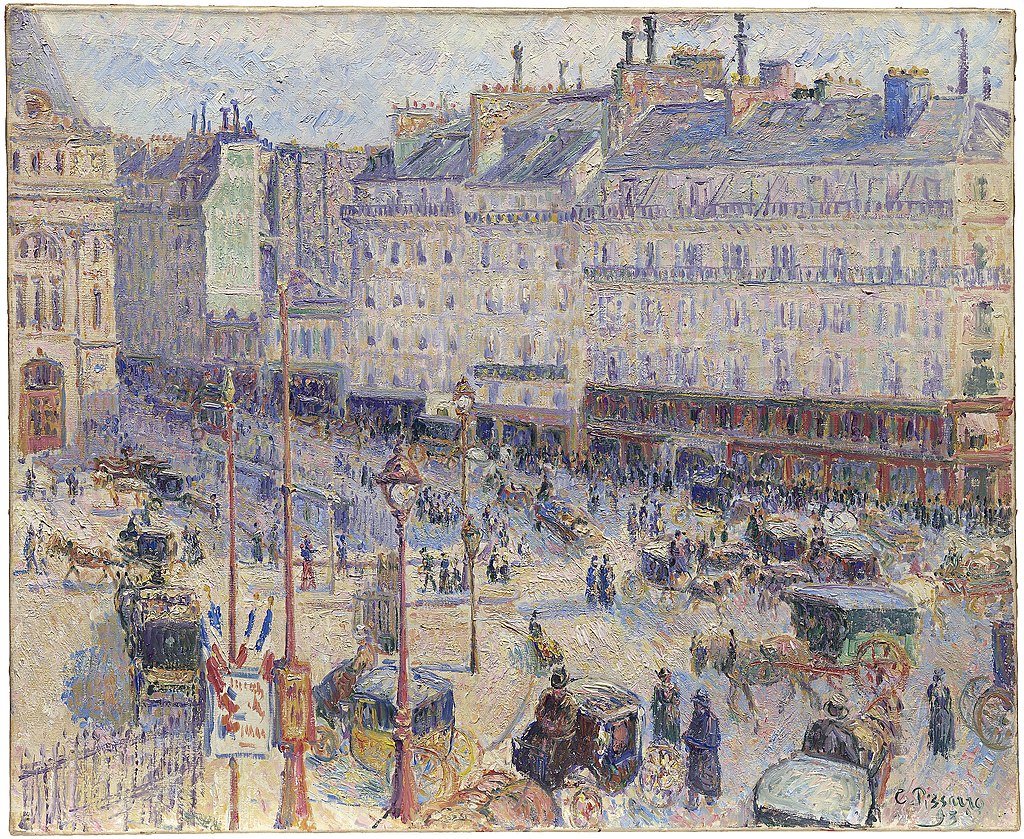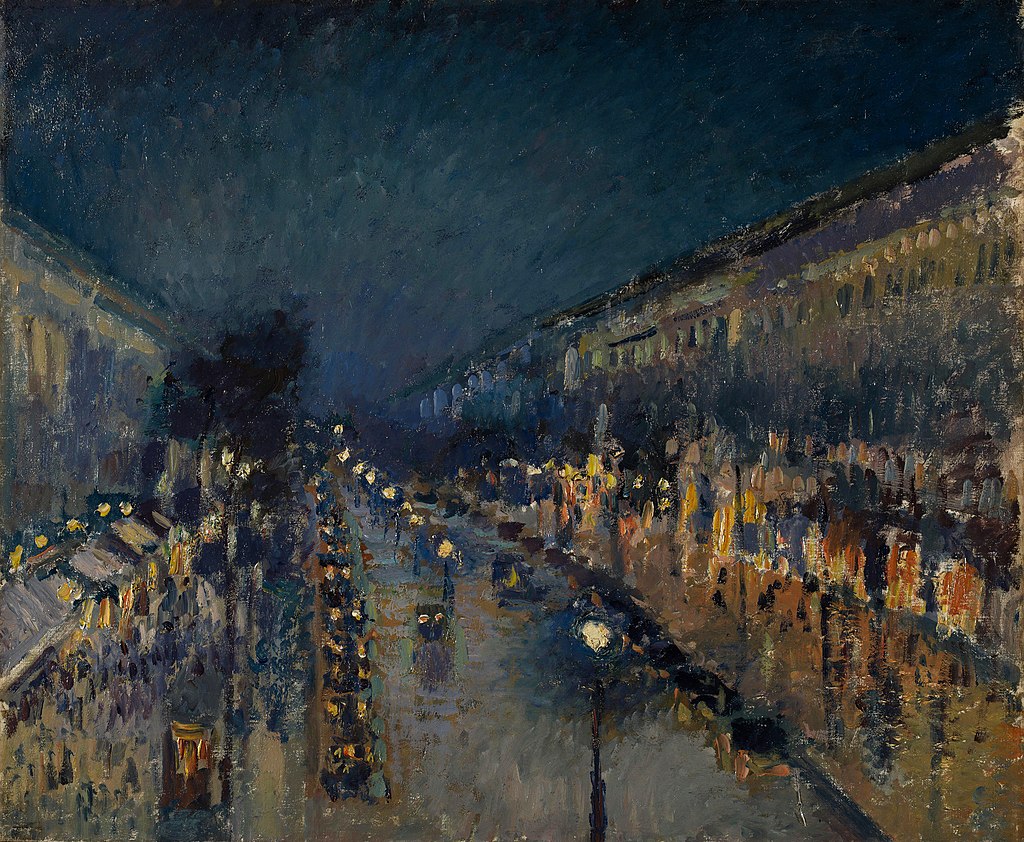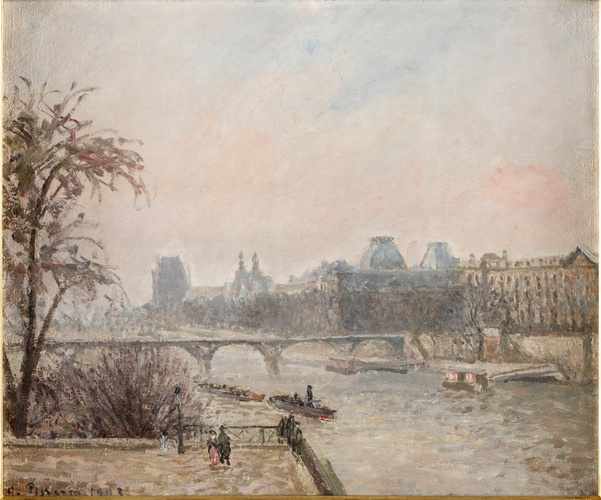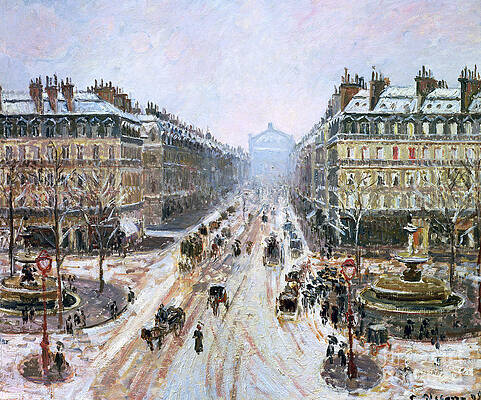Jacob Abraham Camille Pissarro (1830-1903) was the oldest of the Impressionist artists and considered a father figure, teacher, mentor, and supporter. He also was a prolific painter. Pissarro was born on the island of St Thomas, then part of the Danish West Indies. His father Gabriel Pissarro, a French Jew from Portugal, had moved to St Thomas to manage the hardware store owned by his recently deceased brother. He married his brother’s wife, and they had four children. The marriage was a scandal, and Camille and his siblings grew up as outsiders. All four children attended an all-black primary school. He met Danish artist Fritz Melbye in 1849, and Melbye took over Pissarro’s artistic education. He became Pissarro’s great friend and mentor. Pissarro later would do the same for the younger Impressionists. Pissarro and Melbye traveled to Venezuela and painted scenes from Caracas and St Thomas.
Pissarro traveled to Paris in 1855 to serve as an assistant to Melbye’s brother. He studied the work of contemporary Barbizon painters Daubigny, Millet, and Corot, and realist painter Courbet, and all became friends. He was introduced to plein air painting. His first exhibit at the Paris Salon in 1868 was a success. The paintings he exhibited made his reputation, yet they were not of the Impressionist style that he would soon embrace.
The Franco-Prussian war made it necessary for Pissarro to move to London, as was the case with several of his fellow artists. He met the art dealer Durand-Ruel and the artist Monet. He married his mother’s maid Julie Vellary in 1871, and they had seven children, six of whom became painters. On returning to Louveciennes, outside Paris, he found that of the 1500 paintings he had made over the period of 20 years, and had to leave behind, only 40 remained.
The family moved to Pontoise in 1872 and remained there until 1884. Pissarro became one of the group of Impressionists artists who called themselves Société Anonyme des Artistes, Peintres, Sculpteurs et Graveurs. His paintings of working-class people in rural towns were fully Impressionistic. He participated in all eight of the Impressionist exhibitions.

The Place du Havre, Paris” (1893)
Pissarro suffered from a recurring eye infection that became severe in 1893. It prevented him from sitting outdoors and painting en plein air. He was determined to continue to paint outdoor scenes, but from the upper rooms of hotels in the cities of Paris, Rouen, Le Havre, Dieppe, and London. His reputation by that time was well-established and as he hoped his paintings of the new the new Paris designed by Haussmann attracted buyers. Pissarro painted “The Place du Havre, Paris” (1893) (24’’x29’’) from his window of the Hotel Garner during a visit for a few weeks. The large building to the right is the Gare St Lazare train station. Renoir and Monet had painted scenes of downtown Paris, but had long since turned to other themes. Pissarro revived the interest in Paris scenes. The wide avenues, Haussmann buildings, horsedrawn carriages, gas and then electric lights, and the continuous hustle and bustle as seen from above allowed him to capture the energy of the streets.

“Rue Saint-Honore, in the Afternoon, Effect Rain” (1897)
Although city scenes were not a part of his usual subject matter, he excelled in these paintings. He said he could “see down the whole length of the boulevards, almost a bird’s-eye view of carriages, omnibuses, people, between big trees, big houses that have to be set straight.” He chose to depict the most important streets in Paris, and influenced by Monet, he chose different times of day and different weather conditions.
“Rue Saint-Honore, in the Afternoon, Effect Rain” (1897) (32”x26’’) was one of several pieces he painted before moving on. Just over one mile long, Rue Saint-Honore was the center of Paris Haute Couture. High-end fashion houses, boutiques, designer shops, and art galleries attracted wealthy Parisiennes. Several horse-drawn carriages are parked at the curb, while others ply the crowded boulevard. Haussmann buildings line the street. The restaurant on the corner has a red and white awning and tables on the sidewalk. The plaza contains trees, a large fountain, and street lights. People, most with open umbrellas, populate the scene. More awnings and decorated store fronts are across the street. Pissarro was expert at handling the wet street and the gray atmosphere.

“Boulevard Italians, Morning Sunlight” (1897)
From February through April 1897, Pissarro recorded the Boulevard des Italians and the Boulevard Montmartre from his room in the Grand Hotel de Russie. He found “terribly difficult views” for his “Boulevard Italians, Morning Sunlight” (1897) (29”x36”) (National Gallery of Art, Washington, DC).
The street was busy, with passenger omnibuses picking up and discharging passengers among the many individual carriages. Two rows of trees line the street, and the large sidewalks are full of people. Pissarro included a tall red advertising kiosk on the right sidewalk. The kiosks were covered with flyers promoting all manner of things–theatre, opera, restaurants, the circus, cigarettes. The invention of lithography made it possible to print advertisements quicker and cheaper to promote the new bourgeois entertainments. The posters of Toulouse-Lautrec come to mind.

“Boulevard Montmartre at Night” (1897)
“Boulevard Montmartre at Night” (1897) (21”x26”) is considered one of Pissarro’s masterpieces, equal to Van Gogh’s “Starry Night” (1889). Painting at night was difficult, and when successful was exceptional. Gas lights lined city streets in the 19th Century, but they were replaced by the white electric lights in 1878, included in this scene. Street lights were one of Hausmann’s ideasto make Paris safer, and they made night life possible. Pissarro painted 14 scenes of Boulevard Montmartre in sunlight, snow, rain, fog, and mist, and in the morning, afternoon, and evening. Carriages are parked along the sidewalks, waiting for passengers. Shops and restaurants run the whole length of the street. Dashes and dots of brushwork suggest this active scene.

“Boulevard Montmartre at Night” – detail (1897)

“Avenue de l’Opera, Snow Effect” (1898)
Pissarro created 15 paintings in 1898 from his room in the Grand Hotel du Louvre on the Place du Palais Royal. His room provided a view of the Avenue de l’Opera, the Place du Theatre Francais, and the Rue Saint-Honore. In “Avenue de l’Opera, Snow Effect” (1898) (26”x21”), two large roundabouts can be seen on either side of the wide thoroughfare that leads to the distant, newly constructed Paris Opera House (1861-1875). With the industrial revolution in full swing, the newly wealthy middle class formed associations to fund institutions such as the opera house. In the past, opera stages were part of royal palaces and available only to members of the ruling classes. The Paris Opera House, designed by Charles Garnier (1825-1898), is obscured by the mist in this painting, but it was and is grandiloquent. Pissarro chose to show the effects of a heavy snow fall, leaving roof tops and awnings tipped with white. The line of buildings and the tracks in the snow create a strong perspective view.
The years from 1897 until 1898 brought several tragedies into Pissarro’s life. His son Lucien suffered a stroke and another son Felix died of tuberculosis at age 23. The Dreyfus Affair concerned an Army Captain, who was Jewish and wrongfully accused and convicted of being a German spy as a result of antisemitism. Pissarro, a Jew, lost some of his friends who were antisemitic. Never political of religious in his paintings, he did write a few letters in support of Dreyfus’s innocence. He was able to separate politics from painting, and in a letter to his son Lucien to tell him of Felix’s death, he wrote: “I am delighted to be able to try to do these Paris streets, which are so often called ugly, but which are so silvery, so luminous and so lively”.

“Garden of the Tuileries on a Spring Morning’’ (1899)
Pissarro took an apartment at 204 rue de Rivoli that faced the Jardin des Tuileries. He painted six views of the garden. “Garden of the Tuileries on a Spring Morning’’ (1899) (29”x36”) is a depiction of the park, created by Queen Catherine de Medici in 1564, located between the Louvre and the Place de la Concorde. The garden was opened to the public in 1667. The two steeples of the church of Sainte-Clotilde can be seen in the distance. Pissarro’s dealer Durand-Ruel happily took the paintings to sell. The paintings were so successful that Pissarro took the same rooms later in 1899. He created another 14 paintings of the garden and 8 views of the Place du Carousel.

“The Seine at the Louvre” (1903)
From 1900 until 1903, Pissarro painted views of the Louvre from the second floor of a house on Place Dauphine. “The Seine at the Louvre” (1903) (19’’x22”) is his last painting. It is a depiction of an overcast fall day. The buildings of the Louvre are shrouded in a blue-gray mist. Some boats ply the river. A few people are on the Square du Vert-Galant at the lower left. In summer it is a green space with a variety of trees. The Pont des Arts (1803), a pedestrian bridge between the Louvre and the Institut de France, spans the river. It was the first iron bridge in Paris. The bridge became famous in 2008 for the love locks that people attached to the rails.
Pissarro died of sepsis on November 13, 1903. His wife and remaining children were present. Many prominent artists attended his funeral, among them Monet, Renoir, and Matisse. The next generation of French painters, the Fauves and Matisse, recognized the importance of Pissarro to Impressionism and the liberation of art for the future. Pissarro was and continues to be considered the father of Impressionism.
Beverly Hall Smith was a professor of art history for 40 years. Since retiring to Chestertown with her husband Kurt in 2014, she has taught art history classes at WC-ALL and the Institute of Adult Learning, Centreville. An artist, she sometimes exhibits work at River Arts. She also paints sets for the Garfield Theater in Chestertown.



Write a Letter to the Editor on this Article
We encourage readers to offer their point of view on this article by submitting the following form. Editing is sometimes necessary and is done at the discretion of the editorial staff.